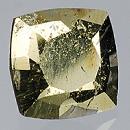|
|
||||||||||||||||
|
||||||||||||||||
|
||||||
|
|
|
|
Bornite
|
|
| | |
| Discovered in 1725; IMA status: Valid (IMA approved 1962) | ||
|
| ||
|
Chemistry |
|
|
| |
|
Cu5FeS4 | |
|
|
Copper Iron Sulfide |
|
Molecular Weight: |
501.84 gm |
|
Composition: |
Iron |
11.13 % |
Fe |
|
|
|
|
Copper |
63.31 % |
Cu |
|
|
|
|
Sulfur |
25.56 % |
S |
|
|
|
|
|
100.00 % |
|
|
|
|
|
|
||||
|
Classification |
|
|
| |
|
Sulfides | |
|
2/B.02-30 | |
|
|
2 : SULFIDES and SULFOSALTS (sulfides, selenides,
tellurides; arsenides, antimonides, bismuthides; sulfarsenites,
sulfantimonites, sulfbismuthites, etc.) |
|
Related to: |
n/a |
|
Members of Group: |
Argentiferous Bornite |
|
Varieties: |
Bornite (of Haidinger), Chalcomiklite, Erubescite, Lefverslag, Peacock Ore, Phillipsine, Phillipsite (of Beudant), Poikilite, Purple Copper, Purple Copper Ore, Variegated Copper, Variegated Copper Ore |
|
Synonyms: |
Bornite (of Haidinger), Chalcomiklite, Erubescite, IMA1962-s.p., Lefverslag, Peacock Ore, Phillipsine, Phillipsite (of Beudant), Poikilite, Purple Copper, Purple Copper Ore, Variegated Copper, Variegated Copper Ore |
|
|
|
|
Crystal Data |
|
|
|
|
|
Crystals pseudocubic, dodecahedral, octahedral, to 6 cm; commonly granular, compact, or massive, disseminated. |
|
|
On {111}; commonly shows penetration twins |
|
|
|
|
|
Physical Properties |
|
|
|
|
|
Poor/Indistinct; in traces on [111] |
|
|
Irregular/Uneven, Conchoidal, Subconshoidal |
|
|
Brittle |
|
|
3.0 - 3.25 |
|
|
5.06 - 5.09 (g/cm3) |
|
|
None |
|
|
Not Radioactive |
|
|
Other: |
Magnetic after heating |
|
|
|
|
Optical Properties |
|
|
|
|
|
Copper Red, Bronze Brown; tarnishing to an iridescent purplish surface after exposure to air and moisture |
|
|
Opaque |
|
|
Metallic |
|
|
R: (400) 19.9, (420) 18.8, (440) 17.9, (460) 17.6, (480) 18.0, (500) 18.8, (520) 20.0, (540) 21.3, (560) 22.9, (580) 24.4, (600) 26.0, (620) 27.5, (640) 28.8, (660) 30.2, (680) 31.6, (700) 32.7 |
|
|
None (opaque) |
|
|
None |
|
|
Weak but noticeable |
|
|
Weak; Color in reflected light: Brown, Pinkish |
|
|
|
|
|
|
|
|
Occurances |
|
|
|
|
|
Geological Setting: |
Associated with and disseminated in mafic igneous rocks, in contact metamorphic skarn deposits, in pegmatites, in medium- to high-temperature hydrothermal deposits, and in sedimentary cupriferous shales; stable below 200° C. |
|
Common Associations: |
Calcite, Chalcopyrite, Garnet, Pyrite, Quartz, Wollastonite, other copper and iron sulfides |
|
Common Impurities: |
Ag, Ge, Bi, In, Pb |
|
Type Locality: |
Jáchymov (St Joachimsthal), Ostrov, Krušné Hory Mts (Erzgebirge), Karlovy Vary Region, Bohemia (Böhmen; Boehmen), Czech Republic |
|
Year Discovered: |
1725 (IMA approved 1962) |
|
View mineral photos: | |
|
|
|
|
More Information |
|
|
|
|
|
| |
|
|
|
|
Bornite is an important copper ore mineral along with other copper ores such as Chalcopyrite, Covellite, Cuprite, Digenite and Tetrahedrite. Good crystals are rare and so Bornite is commonly known simply as a massive mineral ore. It is popular among children in souvenir shops where it is often sold as "peacock ore" or "peacock copper" because of its colorful iridescent tarnish. The colors are from an iridescent tarnish that forms on Bornite upon exposure to air. The tarnish is made of assorted copper oxides or hydroxides that form a very thin layer over the Bornite. In the case of Bornite, the tarnish will have a purplish, violet or blue color. Because Bornite is often intergrown with Chalcopyrite which tarnishes to more greens and yellows, the peacock ore may have many colors ranging from purple to blue to green to yellow. Important
localities for fine crystals include: in the USA, from
Butte, Silver Bow County, Montana, and at Bristol, Hartford
County, Connecticut. In England, from the Carn Brea
mine, Illogan, and elsewhere in Cornwall. Large crystals
from the Mangula mine, Lomagundi district, Zimbabwe.
From the Frossnitz Alpe, eastern Tirol, Austria. At
Dzhezkazgan, Kazakhstan. In the N’ouva mine, Talate,
Morocco. |
|
|
We
have not photographed our Bornite gems
yet. Please
check back soon. |
